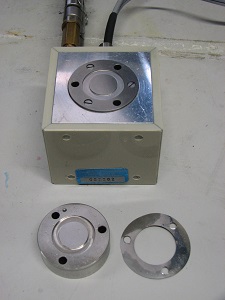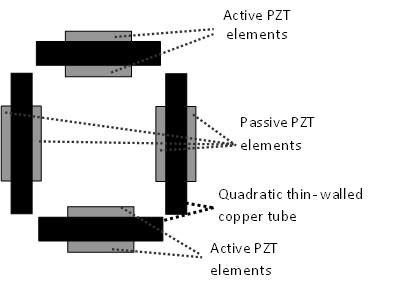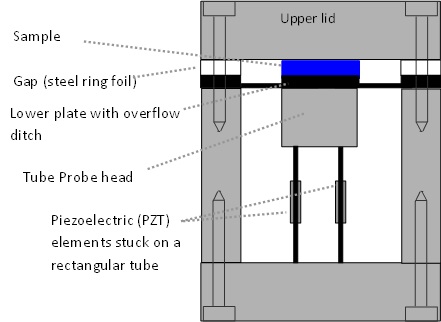Piezo Axial Vibrator (PAV)
The Piezo Axial Vibrator (PAV) is a dynamic squeeze flow rheometer that operates at frequencies between 1 to 10,000 Hz (below its resonance frequency). It was developed by developed by Prof. Pechhold and his co-workers at University of Ulm, Germany and has been used to characterise the linear viscoelasticity (LVE) of soft matter fluids such low viscosity polymeric solutions [Crassous et al. (2005), Hoath et al. (2009)].
The PAV consists of a dynamic press with a thin gap in which liquid is confined. A squeeze flow is generated by piezoelectric drive and the response of the system is measured by piezo-sensors.
| Figure 1a - Photograph of the PAV. The signal generator and computer are on the left and the cell is on the right. | Figure 1b - Photograph of the PAV cell. The top plate is shown in front of the cell together with one of the stainless steel microfoil spacing rings. |
The PAV is built around 4 thin walled stainless steel rectangular tubes on which 8 piezoelectric (PZT) elements are glued (2 on each side of each wall: inside and outside) (Fig. 2a). Four active PZTs are attached to two opposite walls of the tube in order to exert vibrations while additional passive PZTs are fixed to the remaining sides in order pick up the response signal. The top section of the tube and cylinder are tightly covered by a thick stainless plate (which serves as the bottom plate of the sample) with a circular radius R (Fig. 2b). Using a stainless steel microfoil distance ring, the PAV can be hermetically closed with a thick stainless steel, glass or sapphire top plate, leaving a circular gap of depth d (between 5 to 200mm) to be filled by squeeze flow of a test fluid. The lower part of the device is surrounded by a double walled cylinder allowing the circulation of fluid for temperature control.
| Figure 2a - Schematic transverse section of the rectangular tube containing the active and passive piezoelectric elements. |
| Figure 2b - Schematic longitudinal section of PAV cell. |
References
Crassous, J., R. Régisser, M. Ballauff, and N. Willenbacher, “Characterization of the viscoelastic behavior of complex fluids using the piezoelastic axial vibrator,” J. Rheol. 49, 851–863 (2005).
Hoath, S. D., G. D. Martin, T. R. Tuladhar, M. R. Mackley, D. Vadillo, and I. Hutching, “Link between ink rheology, drop-on-demand jet formation and printability,” J. Imaging Sci. Technol. 53, 041208 (2009).




